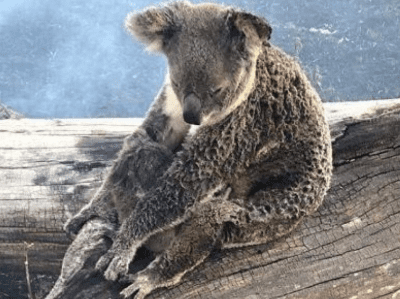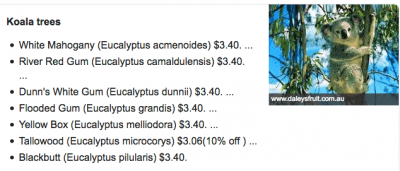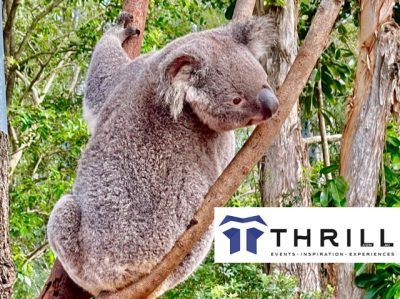Team Building with Thrill will help Koala conservation through team building events planting trees, helping native wildlife habitat restoration.
Koalas are one of our last iconic native animals in Australia – an Aussie battler. Known for their relaxed posture, furry features and amazing ability to climb tall Eucalypts. Koalas may appear to sit dozing, sleeping up to 18hrs per day, digesting specific species of Eucalypts (E.) leaves in the tree canopy.
However they cannot protect themselves from habitat destruction, deforestation and feral animal attacks.
Koala’s need us local’s, groups of people protecting environments and changing our habits.
10% of Thrill Events profits are invested in Conservation programs, Tree Planting, Protecting Australian Wildlife and Koalas
“The koala is an arboreal herbivorous marsupial native to Australia. It is the only extant representative of the family Phascolarctidae”
Source Wikipedia.
Koala’s environment for wildlife has been significantly altered and impacted. Although people love to cuddle a Koala. Let’s take home a more encouraging memory of this predominantly gentle, phasco species. There is little appreciation for how they can survive without the correct food sources and the battles, faced in accessing suitable habitat. Especially during and after devastating bushfires.
Whilst Thrill acknowledges that planting habitat trees or building native nesting boxes will not make an everlasting impact. It will allow for people to understand the plight of not only Koalas, but other vulnerable native Australian species. Encouraging a more proactive approach to sustainable, humane and responsible living practices.

Koalas were once prevalent along the east coast of Australia. Now, ther is less that 10% of the populations once thriving over 200 years ago. In the latest bush fires, it is estimated that 10,000’s of Koalas perished. When you narrow the lense in focus. This means localised areas of extinction of our cuddly Blinky Bill furry eared friends.
If 1,000’s of people, cats, horses or dogs and pets perished, the outcry would be much more enormous.
What value do we put on Australian wildlife?… What is required immediately, is greater protection in the form of conservation of what little Koala habitat remains.

Issues of Rapidly declining Population of Koalas, which are Now declared a Vulnerable Species
- Bushfire threat, Bushfire destruction, Bushfire Death by being burnt alive.
- Loss of Koala habitat and Koala Habitat fragmentation. Land clearing, destruction of E. eucalypt forests. List of suitable Eucalypt Trees for Koalas to eat as primary food source (see below).
- Urbanisation, Industrial areas, Roads and Car strike.
- Feral Animal and Animal Predation – Feral Animal Eradication is required immediately. Koalas are susceptible to mauling, injuries and death by predation by; Foxs. Wild Dogs, Feral Cats and domesticated animals. As Koalas need to forage from tree to tree they scramble across the ground and become easy targets.
- Koalas Diseases and the inability to reproduce due to Chlamydia (see below).
- What can we do to help Koalas? Contact Thrill team events 0459 11 11 29 to get your business, team, employees and staff involved.
Article by Konrad Lippmann, a concerned Australian. Exploring ways in which to conserve Australian native animals, flora and fauna through education and appropriate actions at a local level.
Its time to Plant more Eucalypt Tree Leaves that Koalas Eat and Need to Survive on The Gold Coast QLD and Northern NSW Areas
Scientific Name and/or subspecies, Common Name Preferred soil type and location.
E. major Grey Gum
Suitable for wet coastal forests on soils of low to medium fertility, tolerates heavy frost, annual rainfall 800-‐1200 mm.
E. microcorys Tallowwood
Prefers slopes in deeper moderate to fertile well-‐drained but moist soils, along watercourses, prefers sheltered positions and has medium frost and drought tolerance. Annual rainfall 1000-‐1600 mm.
E. moluccana Coastal Grey Box, Grey box, Gum-‐topped box
Suitable for sloping loam soils of moderate to high fertility on coastal plains and ranges, tolerates saline soils, medium-‐high drought and frost tolerance, annual rainfall 700-‐1000 mm.
E. propinqua Small‐fruited Grey Gum
Suitable for moist clay-‐loam well-‐drained acidic soils of low to medium fertility on slopes and along watercourses. Drought and frost tolerant, annual rainfall 1200-‐1600 mm.
E. robusta Swamp Mahogany
Suitable for acidic soils in low-‐lying near-‐coastal areas, including swampy, seasonally waterlogged soils, very moist fertile soils, heavy clay, sandy clay, alluvial sandy soils, moderately salt-‐tolerant, annual rainfall 1000-‐1600 mm.
E. seeana Narrow-‐leaved Red Gum
Suitable for lower elevations on swampy sandy soils or poorly drained shallow soils on slopes, annual rainfall 1000-‐1800 mm.
E. tereticornis ssp. tereticornis Forest red gum, Blue gum, Red irongum.
Suitable for well-‐drained soil types (heavy clay, clay loam, sandy loam) in alluvial locations, tolerates saline soils and light frosts, tolerates salt-‐laden coastal winds, does not tolerate waterlogged soils, drought‐sensitive, annual rainfall 600-‐2500 mm
Source: Dave Mitchell Landscape Ecologist Australian Koala Foundation – 12/02/2015.

Koalas also die from Bushfires, Animal Predation and Infectious Diseases such as Chlamydia
Chlamydia has devastated nearly every known koala population. The disease, spread through sexual contact or from mother to joey, causes widespread infertility, blindness, pneumonia, urinary tract infections, and can ultimately be fatal. In Northern Australia, more than 20 percent of koalas have chlamydia, with many more harboring the infection.
Researchers have been largely unable to fight the spread of this disease, as koalas need to receive antibiotics from wildlife hospitals. With infection rates so high, it’s nearly impossible to treat every koala, and the antibiotics may be alter the specialized gut microbes koalas use to digest eucalyptus, according to previous studies. Chlamydia pecorum prevalence in South Australian koala (Phascolarctos cinereus) populations: Identification and modelling of a population free from infection. Quoted from Jessica Fabijan (publication Chlamydia pecorum prevalence in South Australian koala (Phascolarctos cinereus) populations: Identification and modelling of a population free from infection).
Please Contact Thrill environmental team of dedicated staff that are mobile to facilitate Conservation and Bushfire Recovery team building activities. Facilitated at all conference centers, meeting venues, hotels and resorts up and down the East Coast of Australia.
To discuss environmental team building activities that can help native wild Koala populations; Please complete a Thrill team enquiry or call Konrad Lippmann m: 0459 1111 29

